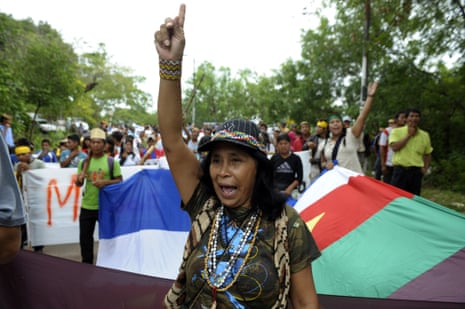On a hillside monument in Asunción, a statue of the mythologized indigenous chief Lambaré stands alongside other great leaders from Paraguayan history.
The other historical heroes on display are of mixed ancestry, but the idea of a noble indigenous heritage is strong in Paraguay, and – uniquely in the Americas – can be expressed by most of the country’s people in an indigenous language: Paraguayan Guaraní.
“Guaraní is our culture – it’s where our roots are,” said Tomasa Cabral, a market vendor in the city.
Elsewhere in the Americas, European colonial languages are pushing native languages towards extinction, but Paraguayan Guaraní – a language descended from several indigenous tongues – remains one of the main languages of 70% of the country’s population.
And unlike other widely spoken native tongues – such as Quechua, Aymara or the Mayan languages – it is overwhelmingly spoken by non-indigenous people.
Miguel Verón, a linguist and member of the Academy of the Guaraní Language, said the language had survived partly because of the landlocked country’s geographic isolation and partly because of the “linguistic loyalty” of its people.
“The indigenous people refused to learn Spanish,” he said. “The [imperial] governors had to learn to speak Guaraní.”
But while it remains under pressure from Spanish, Paraguayan Guaraní is itself part of the threat looming over the country’s other indigenous languages.
Paraguay’s 19 surviving indigenous groups each have their own tongue, but six of them are listed by Unesco as severely or critically endangered. One language, Guaná, has just a handful of speakers left.

Meanwhile, a 2012 census reported that 48% of Paraguay’s 113,220 indigenous inhabitants speak Paraguayan Guaraní as their main language.
Alba Eiragi Duarte, a poet from the Ava Guaraní people, writes in a language– also known as Ava Guaraní – spoken by just 6% of her people.
The benefits of speaking the country’s two official languages were clear, she said – Spanish remains the language of government, and Paraguayan Guaraní is widely spoken in rural areas, where it is a key requisite for many jobs.
But the value of maintaining other tongues was incalculable, Eiragi Duarte said.
“Our culture is transmitted through our own language: culture is language. When we love our language, we love ourselves.”
Hannes Kalisch, linguist and co-founder of an association promoting the Enlhet language, said the shift away from indigenous tongues was often driven by discrimination.
“People stop speaking their language to attempt to avoid discrimination,” he said. “But they have a very clear awareness of that as a kind of betrayal of their own identity.”
Flesh-and-blood indigenous people in Paraguay do not receive the respect enjoyed by the metal chieftain on Lambaré hill. A 2015 UN report found 60% of indigenous people living in extreme poverty – far above the average for the general population.
Paraguayan Guaraní speakers have also faced brutal discrimination and are still stigmatised as rural, poor and uneducated, said Verón. Political and socio-economic systems have prioritised Spanish – often through force – as the language of state, education and power. The language was banned from the education system for much of the long dictatorship of Gen Alfredo Stroessner (1954-89).
“The most flagrant violence that has been committed in Paraguay has been linguistic violence,” he said, “but it isn’t spoken about.”
Important post-dictatorship advances have included a 2012 law that committed the state to place Spanish and Paraguayan Guaraní on equal institutional footing and to protect other indigenous languages.
Ladislaa Alcaraz de Silvero, minister of linguistic policies, said her team had endeavoured to normalise the use of Paraguayan Guaraní across government, but the work – and the preservation of other indigenous languages – was hampered by lack of funds.
“We need information, we need studies of some languages, we need publications,” she said. “All that has a real cost that goodwill alone can’t pay.”
Benigno Giménez, director of indigenous education of the Yshyr Ybytoso people – who have managed to maintain a good level of use of their own language – said teachers strived to reinforce use of their language but have been waiting since 2018 for government support to arrive.
“We want to recuperate our language and culture – to move forward,” he said. “The most important thing is for a child to learn their mother tongue; they can learn other languages afterwards.”
